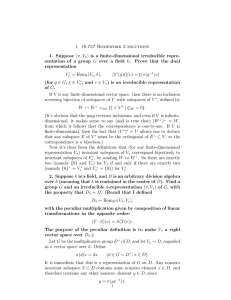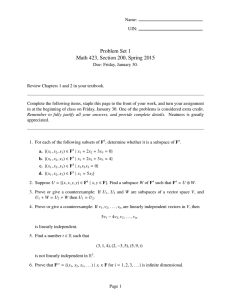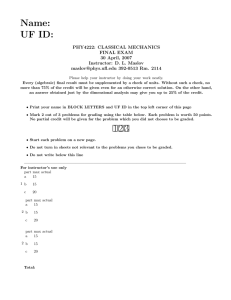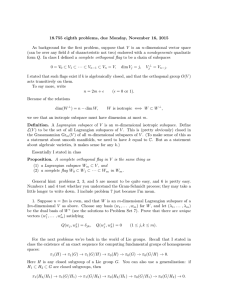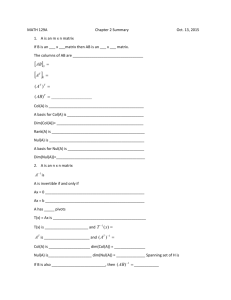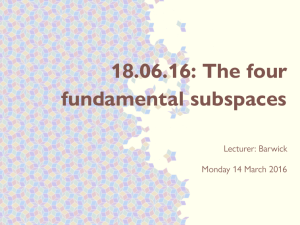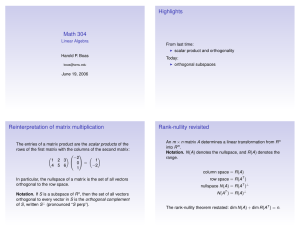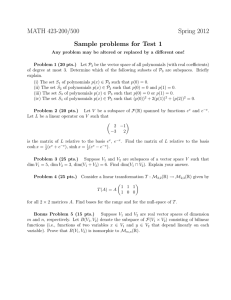Deforming subgroups subgroup H to another H
advertisement
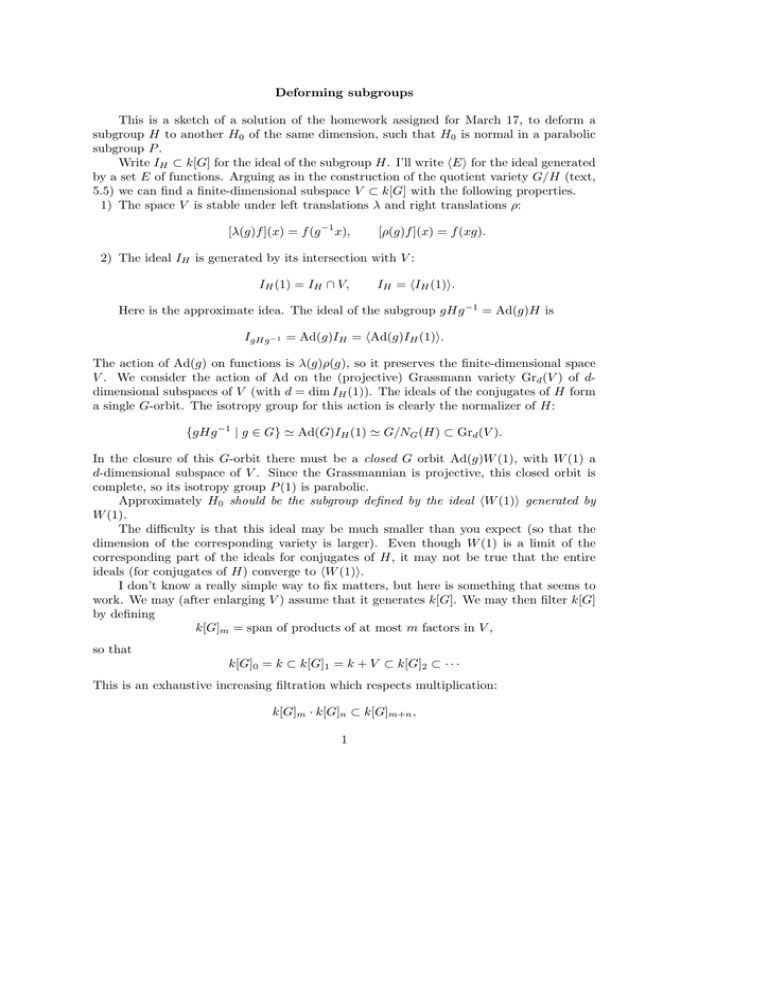
Deforming subgroups
This is a sketch of a solution of the homework assigned for March 17, to deform a
subgroup H to another H0 of the same dimension, such that H0 is normal in a parabolic
subgroup P .
Write IH ⊂ k[G] for the ideal of the subgroup H. I’ll write hEi for the ideal generated
by a set E of functions. Arguing as in the construction of the quotient variety G/H (text,
5.5) we can find a finite-dimensional subspace V ⊂ k[G] with the following properties.
1) The space V is stable under left translations λ and right translations ρ:
[λ(g)f ](x) = f (g −1 x),
[ρ(g)f ](x) = f (xg).
2) The ideal IH is generated by its intersection with V :
IH (1) = IH ∩ V,
IH = hIH (1)i.
Here is the approximate idea. The ideal of the subgroup gHg −1 = Ad(g)H is
IgHg−1 = Ad(g)IH = hAd(g)IH (1)i.
The action of Ad(g) on functions is λ(g)ρ(g), so it preserves the finite-dimensional space
V . We consider the action of Ad on the (projective) Grassmann variety Grd (V ) of ddimensional subspaces of V (with d = dim IH (1)). The ideals of the conjugates of H form
a single G-orbit. The isotropy group for this action is clearly the normalizer of H:
{gHg −1 | g ∈ G} ' Ad(G)IH (1) ' G/NG (H) ⊂ Grd (V ).
In the closure of this G-orbit there must be a closed G orbit Ad(g)W (1), with W (1) a
d-dimensional subspace of V . Since the Grassmannian is projective, this closed orbit is
complete, so its isotropy group P (1) is parabolic.
Approximately H0 should be the subgroup defined by the ideal hW (1)i generated by
W (1).
The difficulty is that this ideal may be much smaller than you expect (so that the
dimension of the corresponding variety is larger). Even though W (1) is a limit of the
corresponding part of the ideals for conjugates of H, it may not be true that the entire
ideals (for conjugates of H) converge to hW (1)i.
I don’t know a really simple way to fix matters, but here is something that seems to
work. We may (after enlarging V ) assume that it generates k[G]. We may then filter k[G]
by defining
k[G]m = span of products of at most m factors in V ,
so that
k[G]0 = k ⊂ k[G]1 = k + V ⊂ k[G]2 ⊂ · · ·
This is an exhaustive increasing filtration which respects multiplication:
k[G]m · k[G]n ⊂ k[G]m+n ,
1
and the associated graded ring is a finitely generated commutative algebra over k (the
quotient of a polynomial ring in dim V variables by a homogeneous ideal).
Now we can define
IH (m) = IH ∩ k[G]m ,
dim IH (m) = dm .
Define a “partial flag variety”
X(m) = {chains of subspaces W = {W (1) ⊂ W (2) ⊂ · · · ⊂ W (m) ⊂ km [G]}}
subject to the requirements
W (j) ⊂ k[G]j .
dim W (j) = dj ,
This is a projective algebraic variety. The choice of V and the construction of the filtration
makes k[G]m stable by ρ, λ, and Ad, so these actions apply to X(m). Forgetting the largest
subspace defines a proper morphism
π(m + 1): X(m + 1) → X(m).
Inside X(m) is the G-orbit
Z(m) = Ad(G)IH .
Since by construction IH (1) generates IH , it is very easy to check that all the isotropy
groups
{g ∈ G | Ad(g)IH (i) = IH (i), 1 ≤ i ≤ m}
are equal to NG (H); so
Z(m) ' G/NG (H),
m ≥ 1.
Each closure Z(m) is Ad(G)-stable and closed in the projective variety X(m), and
therefore complete. I am going to choose a compatible family of closed G orbits
O(m) = Ad(G)W0 ⊂ Z(m).
The notation is a little ambiguous. The flag W0 in the preceding formula consists of m
subspaces
W0 (i)
(1 ≤ i ≤ m);
but the m does not appear in the notation. When I choose another flag W00 in Z(m + 1),
its first m subspaces W00 (i) will be equal to W0 (i). So calling the new flag W0 is more or
less harmless.
We have already seen that π(m + 1) maps Z(m + 1) isomorphically onto Z(m); so
π(m + 1): Z(m + 1) → Z(m)
is a surjective proper map.
2
Begin by choosing a closed orbit
O(1) = Ad(G)W0 (1) ⊂ Z(1).
Once the closed orbit
O(m) = Ad(G)W0 ⊂ Z(m)
is chosen, its preimage
π(m + 1)−1 (O(m)) ⊂ Z(m + 1)
is necessarily a complete subvariety, preserved by Ad (since π(m+1) is proper and respects
all the group actions). Consequently there is a closed orbit
O(m + 1) = Ad(G)W00 ⊂ π(m + 1)−1 (O(m)).
We may choose the orbit representative W00 to project to W0 , which means exactly that
the first m subspaces in the flag W00 agree with those already chosen.
Because the orbits are closed, the isotropy groups
P (m) = {g ∈ G | Ad(g)W0 (i) = W0 (i)(1 ≤ i ≤ m)}
are all parabolic.
We now consider the increasing family of ideals
I0 (m) = hW0 (m)i ⊂ k[G].
Because k[G] is Noetherian, this family is eventually constant:
I0 (m) = I0 (M )
(m ≥ M ).
We call this limiting ideal I0 , and define
H0 = variety of I0 .
Because I0 was constructed as a limit of ideals, it is easy to check that
I0 ∩ k[G]m = W0 (m)
(1 ≤ m < ∞),
and in particular that
dim(I0 ∩ k[G]m ) = dim(IH ∩ k[G]m )
(1 ≤ m < ∞).
From this knowledge of Hilbert functions we conclude that H0 has the same dimension as
H.
We want to show that H0 is a group. Recall the product morphism
µ: G × G → G,
µ(x, y) = xy,
3
and the corresponding algebra homomorphism
µ∗ : k[G] → k[G] ⊗ k[G].
If A, B, and C are closed subsets of G, with ideals IA , IB , and IC , then the ideal of A × B
is IA ⊗ k[G] + k[G] ⊗ IB ; so the condition A · B ⊂ C is equivalent to
µ∗ (IC ) ⊂ IA ⊗ k[G] + k[G] ⊗ IB ).
In particular, the condition that H is closed under multiplication is
µ∗ (IH ) ⊂ IH ⊗ k[G] + k[G] ⊗ IH ).
For every positive integer m, the subspace IH (m) is finite-dimensional; so there must be
positive N (m) so that
µ∗ (IH (m)) ⊂ IH (N ) ⊗ k[G]N + k[G]N ⊗ IH (N )).
Because this condition (concerning behavior of subspaces under the fixed linear map µ∗ on
fixed finite-dimensional spaces like k[G]m ) is satisfied for all the ideals (and corresponding
flags) IgHg−1 , it is satisfied by the limit ideal I0 as well. It follows that H0 is closed under
multiplication.
Similar arguments show that H0 is closed under inversion and contains the identity
of G, so H0 is a subgroup.
The ideal I0 may not be radical, so the ideal of H0 may be slightly larger than I0 ; but
at any rate it is clear that NG (H0 ) contains the isotropy group P (M ) of the closed orbit
O(M ). Since P (M ) is parabolic, the larger group NG (H0 ) is parabolic as well.
4

